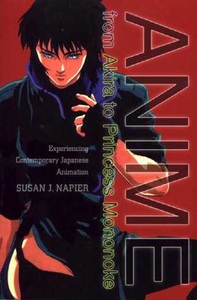Review
by Mikhail Koulikov,Anime from Akira to Mononoke:
Experiencing Contemporary Japanese Animation
| Review: | ||||||||
Probably one of the most frustrating things about being an anime fan is being thoroughly unable to explain the reason for the obsession to the rest of the world in terms they will actually understand. As fans/otaku we know Japanese animation is wonderful and elaborate and worthy of every minute and dollar we devote to it…but try telling that to a parent, co-worker or teacher, and chances are, the most you'll be rewarded with will be a blank stare.
Until now, that is, as Dr. Susan J. Napier rides to our collective rescue. Napier, a Harvard-trained PhD and currently a professor at the University of Texas, does not hold her punches. On the very first page of the book, the question is posed – just why is anime worth of being looked at seriously, as more than mere cheap disposable entertainment that, incidentally, happens to also be at the root of a multimillion-dollar industry. Almost all of the rest of the volume, then, is spent answering the question in several ways. The crux of Dr. Napier's argument is that Japanese animation can – should – be approached critically the same way one approaches other media, whether literature or film. Therefore, apart from two chapters discussing anime as something that is, despite the apparent contradiction, both uniquely Japanese and uniquely shaped by influences from abroad, a majority of the book consists of analyses of the ways specific themes are addressed in anime, and the different ways in which several titles can treat the same general theme or concept in completely different ways. The argument itself is presented largely through citing established cultural and media studies and criticism, and showing that, for example, the writings of Frank Kermode on the theory of fiction, or of Mikhail Bakhtin on “controlled chaos”, can apply directly to anime. Obviously, such a presentation presupposes at least a passing familiarity with a whole range of other academic writing and scholarship. At the same time, Dr. Napier is not content with a mere catalogue; as one of the first persons to address Japanese animation from an academic standpoint, it is her privilege to also begin to generate a theory that could, at least from a cultural studies standpoint, apply to anime as a whole. She does, and presents a discussion of the three “modes,” or general thematic types, of anime – apocalyptic, festival, and elegiac. As she progresses with discussions of individual titles, exactly what she means by the three terms, and how they can be seen to exist on a layer beyond that of genre or the common divisions associated with anime (for example, shoujo vs. shounen) becomes clear. As far as the faults and inadequacies of this volume go, they are fairly understandable – though that in of itself does not necessarily excuse them. Napier is a cultural scholar by training; therefore, she approaches individual titles almost entirely from the perspective of plot and context and meaning. There is virtually no discussion either of anime as cinema and the technical merits of the medium, or of the anime “industry” and the fact that it is, first and foremost, a consumer good. Another issue is that in the end of all things, Napier mentions maybe a couple of dozen titles, out of hundreds if not thousands. She does acknowledge this, but in any case, the effect is that in a way, she misrepresents Japanese animation as being far more profound and meaningful and serious than it, taken as a whole, actually is. That is, sure, a title like Ghost in the Shell or Princess Mononoke – or even Urusei Yatsura: Beautiful Dreamer – may yield itself quite well to analysis, and can hold its own against quite a few works of literature or film…but when the entirety of Japanese animations is considered, titles like these are a distinct minority. Much has been said, as well, about the several factual errors that creep into the text (such as, for example, a plot description given an incorrect episode number). While to an otaku already thoroughly familiar with the source material, these may seem huge, it must be remembered that this is not a book aimed at the anime fan but rather at the open-minded layman. Therefore, errors such as this are regrettable but really do not detract from the quality of the work as a whole. Exactly how much you as a fan will enjoy Napier's work depends first and foremost on your ability to accept, for example, an argument that the hentai title “Legend of the Overfiend is finally not so much about sexuality as it is about the transgressive nature of growing up and the iniquity of the parental generation,” and in general, an insistence on referring to anime and animation in general as “texts.” If you are, especially if you are already familiar with the “rules of the game”, the academic jargon, and the references and sources she uses, you should have no problem accepting the points and theories presented. If, however, the very concept of “academic writing” turns you off from the get-go, this is not a book for you. Ultimately, the most important thing to remember when looking at this book is that it neither is, nor attempts to be, the final and authoritative treatise on Japanese animation. It is merely one of what appears to be a growing number of academic volumes on the medium. It sets out to present only one of a number of possible approaches to the academic study of anime, and succeeds quite admirably. |
||||||||
| Grade: | |||
|
+ Does an excellent job of showing how anime can have a place in the academic world |
|||
